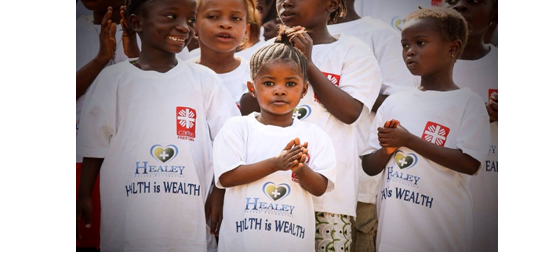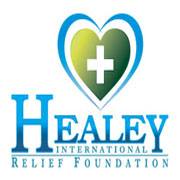
Ravaged by civil war and the Ebola Crisis, the West Africa nation of Sierra Leone has seen its healthcare service reduced from being a shining example of African ability to a virtual memory. Rebuilding the country’s healthcare infrastructure is no easy task, but since 2008, the Healey International Relief Foundation (HIRF) has been leading the charge through its Charity Health Network (CHN) program.
Founded in 2001 and headquartered in Lumberton NJ, USA, the Healey International Relief Foundation (HIRF) is a 501(c)3 public charity established to improve the quality of life of individuals and families in war-torn Third World countries.
Healey IRF has been aiding in relief activities in Sierra Leone since 2005, with the regeneration of the country’s healthcare infrastructure its primary undertaking. Amongst the individual projects supported by the Foundation are St. Mary’s Home for Children (Bo), Fatima House of Light (Freetown), St. Stephen’s Home for Amputees (Newton), Serabu Hospital (Bo) and the National Health Organization – now the Charity Health Network (CHN).
But rather than simply seeking donations, the Foundation believes that investing in infrastructure and education is the best way to improve lives. That’s because it increases the capacity of communities to become self-sustaining. So, the Foundation supports communities by delivering healthcare, clean water, food, training and other programs.
Rebuilding The CHN
Healthcare is a huge issue in the country, with statistics highlighting how essential the need for development and improvement is. Sierra Leone has
For almost 200 years, the Catholic Church was the chief provider of medical care and education in the former British colony, building, running and staffing hospitals and clinics around the country. In 1987, the church established the National Catholic Health Organization (NCHO) to oversee the network, which had by then grown to 48 clinics and hospitals.
 This new structure was proving to be a major success when civil war broke out in 1991, and in 1996, the Revolutionary United Front (RUF) destroyed all hospitals and clinics associated with any Christian denomination. It was not until 2008 – 6 years after the Civil War ended – that plans to resurrect Sierra Leone’s healthcare system were announced, with Healey IRF undertaking the project.
This new structure was proving to be a major success when civil war broke out in 1991, and in 1996, the Revolutionary United Front (RUF) destroyed all hospitals and clinics associated with any Christian denomination. It was not until 2008 – 6 years after the Civil War ended – that plans to resurrect Sierra Leone’s healthcare system were announced, with Healey IRF undertaking the project.
With support from USAID, local NGOS and John Hopkins’ Hospital, the project took a first leap forward in 2009 when Serabu Hospital was re-opened. Once the foremost hospital in the nation, but destroyed during the war, it is once again a leading maternal care environment, servicing over 200 beds a day and housing an associated nursing school.
Spurred on by its first success, Healey IRF set about its task of re-establishing the NCHO. It renamed the body the Charity Health Network (CHN) to reflect the non-denominational nature of the new infrastructure, and implemented a plan for more than 30 healthcare clinics throughout the country. In all, the plan incorporates preventative care, education, training, community involvement and partnership, as well as achieving healthcare sustainability.
The First Step: The Monsignor Daniel Sullivan Health Clinic
In 2014, construction of its first pilot clinic began, located on the grounds of the St. Stephen’s Home for Amputees in Newton – a clinic to serve the 300 residents of the St. Stephen’s community and a greater catchment area of 24,000 people.
Officially opened in May 2015, and located 24 miles east of Freetown, HIRF Monsignor Daniel Sullivan Health Clinic has already made a huge difference to the community it serves – still considered an “Ebola hot zone.” In fact, although not officially completed, the clinic was operating during the outbreak, helping and redirecting people who were sick and unsure of where to seek help.
Named in honor of Monsignor Daniel Sullivan, the founding Executive Director of HIRF, who passed away in 2013, the clinic is overseen by an in-country medical doctor, community health officer and two nurses, as well as some volunteers.
More To Come
The completion of Monsignor Daniel Sullivan Clinic is just the first step, but progress since has been hampered by the Ebola Crisis and monsoon rains and flooding. But 3 more clinics are earmarked for reconstruction over the next 3 years.
By 2018, Healey IRF is expected to have 5 clinics up and running at full capacity. From that point, the project will continue until all 30 clinics around the country are fully operational. When exactly that will be achieved is difficult to estimate.
Mobile Outreach Clinic
Since April 2015, a mobile outreach clinic program has also been in operation, in coordination with Caritas Freetown. Created to provide healthcare to those unable to access proper resources, the mobile clinic was particularly valuable in caring for Ebola patients and (more recently) the thousands of people left homeless by monsoon floods and rain, bringing much-needed medical care, medicines and food.
The mobile clinic operates several times a week, dependent on need or urgency. But Healey IRF plans to add more mobile units allowing them to operate every day, a development that will expand healthcare reach dramatically, while also providing a means to further educate people of different communities.
Healthcare, Ebola And More
Developing the Charity Health Network is just one of Healey IRF’s projects. There are several others, all of which relate to health and community, not least are the Orphan and Vulnerable Children (OVC) and Women Empowerment Through Education projects.
For more information on the Foundation, visit their MyCharityMap Profile Page.
For more details on their range of projects, events and activities, or to make a donation – whether it be in cash or supplies – check out the official Healey IRF website.
For more on how Sierra Leone is rebuilding through eco-tourism after the disasters of recent decades, read our report MyTravelsMap.
Image: Children of Sierra Leone celebrate. Photo from Healey IRF. Published through Creative Commons (CC 2.0).